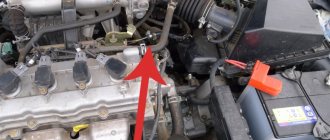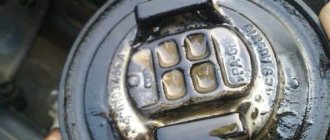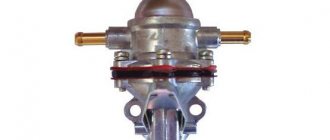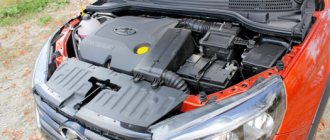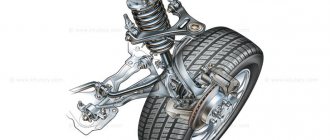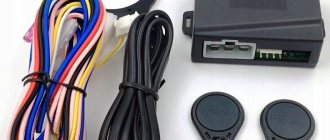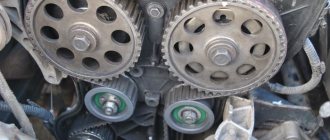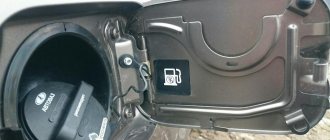You can identify bad gasoline at home by several signs: the acrid smell of exhaust gases, the color of the fuel, characteristic carbon deposits on the spark plugs and interruptions in engine operation. Let's look at how to identify low-quality fuel, what to do in this case, and the possible consequences and causes of the Check Engine light coming on.
Where does low-quality gasoline come from?
One of the main reasons is human greed. It manifests itself both at gas stations and among people who simply want to make money. At a gas station, gasoline can be diluted or a cheap additive can be added to it. In addition, the fuel may be dirty. Naturally, because of this, its positive properties suffer.
If we talk about people who sell gasoline cheaply, then there is banal theft of gasoline. As a rule, gasoline drained from different cars is poured into one container and sold. And it may contain both 92 and 100 gasoline. Due to a violation of the octane number, engine operation may be disrupted.
Why is methanol dangerous?
Methanol is methyl alcohol, known from horror stories about counterfeit alcohol. It turns out that this is a poison not only for humans, but also for a gasoline engine. It’s also a cheap (albeit prohibited) way to increase the octane number of fuel.
The calorific value (“calorie content”) of methanol is two times lower than that of gasoline, so the engine cannot develop full power with it. But that's not so bad. Methanol contains a lot of bound oxygen, which confuses the machine's electronics. Oxygen sensors, detecting excess gas, evaluate the mixture in the cylinders as lean, and the control unit mistakenly increases the fuel supply - consumption increases, the engine “sausages”. The excess fuel does not have time to burn completely in the cylinders, flying out into the exhaust pipe and melting the catalyst honeycomb.
The icing on the cake is the high aggressiveness of methanol to rubber seals and the decomposition of engine oil. Driving for a long time on “alcoholized” gasoline is guaranteed to lead to expensive engine repairs.
Signs of bad gasoline
Bad fuel will never pass through the car without a trace. During operation, various signs of low-quality gasoline will certainly emerge. And here they are:
- misfires;
- check engine;
- errors on the oxygen sensor;
- power reduction;
- increased fuel consumption;
- unpleasant exhaust smell.
In general, the most important indicator of such fuel is that it burns poorly. And here one of the first signs suggests itself: misfires. Misfires are conditions in which the fuel in the combustion chamber does not ignite. This happens if the spark plug is faulty or the fuel itself has not burned. In this situation it is precisely the latter.
The instrument panel will not remain indifferent either. During misfires, the Check Engine may blink or stay on constantly. If this happened once and without consequences, it is recommended to read the errors. As a rule, the errors will include misfires on all cylinders and with a 90% probability there will be an error on the oxygen sensor. The oxygen sensor will immediately suspect something is wrong if the fuel is bad. After all, the exhaust will be of appropriate quality.
Naturally, against the backdrop of all this, there will be a serious decrease in power. Sometimes the car reacts very sluggishly to the gas pedal, or may even stall. On top of everything else, you can add increased fuel consumption.
Another interesting sign of bad fuel is the strong smell of exhaust gases. Try to gas it; if light-colored smoke comes out of the pipe, which was not there before, then you need to go to the pipe and sniff.
Already near the pipe there will be an unpleasant and very pungent smell. Typically, bad fuel smells as if it is something rotten. This smell manifests itself best indoors - for example, when starting the engine in the garage.
Ambulance on the road
- If a truck or car does not start when hot on the road, then first you need to put a slight load directly on the battery.
- You can just turn on the music. Drivers of cars with an injection engine will need to turn on the ignition and wait a little while until the gasoline pump pumps enough fuel.
- Those who have a car that uses a manual transmission will first need to press the clutch pedal and then try to start the engine.
- If the methods described above do not help, you can use more proven methods: “light” the car battery from a neighbor or replace it altogether .
- You can also try push starting, but this option is only suitable for cars using a manual transmission.
If the engine starts, it is better not to turn it off for about an hour . Only then will it be possible to bring the battery back to normal so that it will definitely not fail the next time you use it.
In order for your car to work well and start without problems when hot, it is important to refuel only at proven gas stations and be sure to monitor the entire gasoline or diesel supply system in the car. If you don’t do this at all, then soon you will definitely encounter the fact that your vehicle does not want to start hot. You will lose time, nerves, and also a lot of money, since repairs today are not cheap.
What will be the consequences?
Driving on such fuel will definitely come back to haunt the car owner. First of all, the spark plugs will fail, which will simply be filled with bad gasoline in incredible quantities. After several hundred such passes, the insulator will break through, and they will simply stop working. In the worst case, it will break through the ignition coil.
The second unpleasant moment is contamination of the entire fuel system. From the tank to the injectors, bad gasoline will leave varnish deposits that are difficult to burn. And the worst thing is that they will make it difficult for normal gasoline to pass through the fuel line. And it’s good if it’s just a matter of cleaning and flushing the system. In the worst case, the injector will fail. And the cost of injectors sometimes exceeds 10 thousand rubles (1 piece).
Well, the last one is a catalyst. What is not burned in the combustion chamber will burn out in the catalyst and increase its temperature. Ultimately, these popping noises in the muffler will cause a nasty hole to appear in the system. And the worst case scenario is that the honeycombs are destroyed.
The car does not start well when hot: the main reasons
If the car suddenly stops starting when hot, it is necessary to determine the main reasons that could be causing this. It is necessary to analyze and reduce the total number of possible culprits for engine performance problems. Among the most common causes of the described problem, three can be identified.
No compression
If the car does not start well, then low compression or its complete absence may be to blame. This state of affairs may be caused by the following reasons:
Coked rings.
- Severe wear of the cylinder-piston group.
If only a major overhaul will help with the second problem, then the first problem can be quite easily solved using prevention. During the use of the car, carbon deposits and various varnish contaminants are formed inside the engine. This is inevitable, because soon carbon deposits no longer allow the compression rings to work normally. The compression gradually decreases and the pressure is no longer enough to ignite the fuel normally.
A good prevention of this malfunction is the use of special flushes of the oil system. Using them you can easily remove carbon deposits.
Fuel is not supplied
If a car doesn’t start well when it’s hot, it’s not always the fault of some component of the car. The reason may lie in the fuel used.
If the fuel is of poor quality, the car will not start well even when cold.
Various additives often float in the fuel, which gradually finish off the engine. If diesel freezes too much, it will turn into real jelly, and the fuel pump simply will not be able to pump such a mass.
No spark
The car starts poorly and takes a long time when it is hot and if there is no spark. The situation is typical in such cases:
- Broken spark plugs.
- Broken ignition coils.
- Broken electrical connections of the ignition mechanism.
In this situation, you will have to identify the causes and eliminate the source of the trouble that is preventing the car from starting. It is necessary to replace the spark plugs with new ones and check all ignition connections.
Is it possible to drive like this?
It is not advisable to drive on bad gasoline, based on the consequences above. But if the trip is not long, for example, to a normal gas station or service station, then you can go. The most important thing is not to try to squeeze everything out of the car. Gently press the gas and without sudden maneuvers. All the same, she will not be able to move as the car owner needs.
If the trip promises to be long, then you need to get rid of bad gasoline and flush the power system. Only after this can the car be returned to normal operation.
Let's sum it up
There are many options for purchasing fuel. Today, the high price of gasoline gives rise to various frauds with this valuable product. However, we recommend purchasing gasoline and diesel fuel only at certified gas stations. There is a better chance of getting high-quality fuel here than from a stranger in a canister. There are a number of features of each gas station that are worth knowing about. We are talking about individual fuel level, quality of service, willingness to accept a complaint and withstand other troubles. But this does not always mean that the gas station sells really good fuel.
Without independently checking a sample of gasoline or diesel fuel, you will not be able to determine with high accuracy what kind of gasoline is sold at a gas station. And in this case, you are not insured against the fact that once you get a good batch, and in subsequent purchases of gasoline at the same gas station they will sell contaminated liquid instead of normal fuel. No one gives a guarantee of quality, but it is simply necessary to be responsible for the safety of your car. So use all available means of checking gasoline or diesel fuel at a gas station and fill only with high-quality fuel. Which gas stations do you prefer to refuel your car at?
What to do if you fill in with low-quality fuel?
The very first thing to do when you notice symptoms of bad fuel is to fill up with good gasoline. It is better if its octane number is slightly higher than what you usually fill up with. It usually contains additives necessary for cleaning, which will help remove the remaining bad fuel from the system through dilution.
As a rule, this helps, but the best option would be to flush the entire system. To flush the injector, there are two ways:
- using the station;
- using additives.
The first method is applicable for service stations when there is special equipment for cleaning injectors. If you don’t have it, you can make it yourself from a plastic bottle and a compressor. The second method is suitable for almost everyone, especially if trouble occurs on the road.
If you refuel with bad gasoline, but managed to dilute it with good gasoline, you can flush the system and help the fuel burn using additives that increase the octane number. To do this, pour the appropriate additive into a full tank of gasoline in the proportions specified in the instructions and onto the highway. You need to drive the engine for a long time at high speeds. The track is the most ideal place for this.
To flush the system even better, you need to remove the gas tank. It is dismantled from the car, after which all the gasoline that is there is drained from it. It can no longer be used, but in the future it will do to wash something. After this, diesel fuel, various cleaners, and additives are poured into the gas tank and let it splash well. After this, all the contents must be poured out. The procedure is repeated until clean technical liquid pours out of the tank.
Poor starting on a hot injector: what to check
An injection engine is a little more complex than a carburetor engine. Thus, there are more reasons why such an engine will be difficult to start:
- Coolant temperature indicator. It can break down in the heat and provide false information to the ECU that the temperature of the special cooling fluid has exceeded the norm.
- Ignition system.
- Crankshaft position indicator. Failure of this mechanism leads to improper functioning of the ECU, which will prevent the engine from starting.
- Fuel pump. You need to check the check valve.
- Idle mechanism.
- Air flow indicator. In hot weather, the mechanism may not cope with its functions at all. In addition, there is always a chance of its complete or partial failure.
- Fuel injectors. The fine fraction of fuel evaporates at high temperatures, thus forming an enriched fuel mixture. Subsequently, problems begin.
- Fuel pressure regulator.
How to avoid refueling with bad fuel?
The best protection against bad gasoline is not to fill it up. But how to distinguish bad gasoline from good? First, you need to avoid untested gas stations. Bad gas stations immediately reveal themselves by their low prices or very strange licenses. As a rule, sellers are reluctant to show papers for the fuel they sell.
Secondly, bad fuel has a pungent and unpleasant odor. We have already talked about this. If the exhaust smells bad, then the gasoline itself will smell accordingly. So refuel only in trusted places and there will be no problems.
How to claim compensation from a gas station?
If you become a victim of deception and fill up with bad gasoline, the gas station must answer for this misunderstanding. Rospotrebnadzor gave us complete instructions for action.
First of all, you must have a receipt. Without a receipt, any claims will be void. After detecting malfunctions, you must take the car to a service center and write a written complaint to the management of the gas station. Before starting repairs, gas station representatives must take fuel samples from the tank and send them for independent examination. If it confirms the poor quality of gasoline, then the gas station will bear the costs, otherwise the car owner will.
If there is no response to the claim, you can safely go to court and conduct an examination yourself.
Difficult to start on a hot diesel engine
- A diesel engine may sometimes also not start when hot. This is due to malfunctions of the following spare parts:
- Coolant indicator. It may break down and start transmitting incorrect data to the ECU.
- Ignition system.
- Crankshaft position indicator.
- Mass air flow indicator.
- High pressure fuel pump. This mechanism can break due to significant wear of the bushings and internal oil seal. Air enters the fuel pump from under the internal seal, after which it is simply impossible to gain the required operating pressure.
- Diesel pressure regulator.


